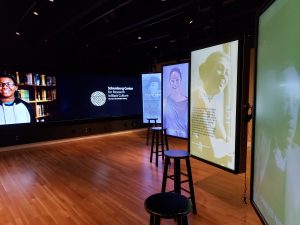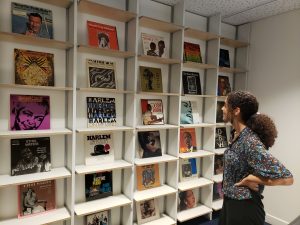Alexandria Shaw, Film and Africana Studies, Class of 2021
Professor Mia Mask, Professor of Film on the Mary Riepma Ross ’32 Chair
This summer, I worked with Professor Mia Mask on analyzing changes in African American representations in popular culture from the 1830s-present day. Our primary focus was on the evolution of Black representation in television from its inception until today. Together we studied and discussed the works of Robin Means Coleman, Bambi Haggins, Yuval Taylor, Christine Acham, Donald Bogle, Tommy Lott, and numerous other scholars who have studied the range of Black performances and stereotypes in American culture (i.e., comedy sketch shows, sitcoms, and dramas).
An exhibit at the Schomburg Center in July 2019.
We traveled to the Schomburg Center for Research in Black Culture in Harlem to study one of the most under-acknowledged and under-analyzed sections of media, Black documentary television. Here, at the Schomburg’s Moving Image and Recorded Sound Division, we viewed programs such as Black Journal, SOUL!, and Another Voice. All of these programs were Black produced and hosted shows narrating the social and political issues facing Black America in the late 1960s and 70s.
Alexandria taking notes on William Greaves’ Still a Brother in the Moving Image and Recording Sound Division.
Following our readings and visits to the Schomburg, we compiled our notes of Black television into eight eras:
→ The Minstrel Era (1830-Mid 1900s)
→ The Era of the Servile and Inept (1950s)
→ The Era of White Normalcy (Mid 1950s – Late 1960s)
→ Uplift: The Black Documentary Television Era (Mid 1960s-1970s)
→ The Assimilationist Era (Mid 1960s-1970s)
→ Family Values (Early 1970s-Late 1990s)
→ The Double-Voiced Era (1990s -2010s)
→ Elliptical Blackness (2000s – Present Day)
Each of these eras is significant in understanding how Blackness, femininity, and sexuality are explored on screens at home. Through every decade, more image-makers working for production studios are diversifying and telling stories that relate to a larger range of the Black experience. We have just begun to evaluate the harmful and demeaning stereotypes embedded within television and have noted how these images have permeated modern day entertainment. With much room for improvement in the entertainment industry, the steps being taken by producers, directors, and screenwriters of color suggests a more promising future for television.



